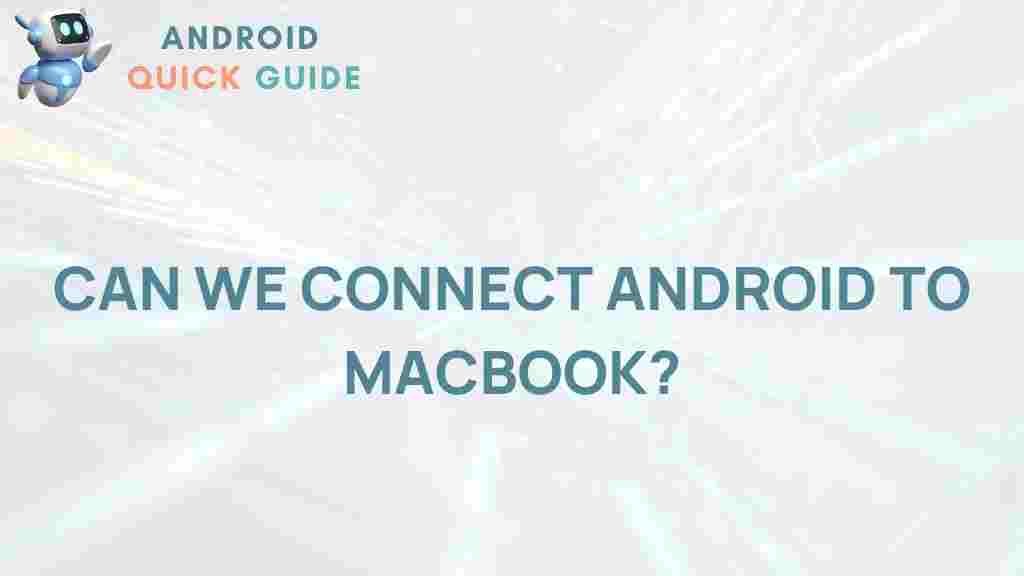Unveiling the Mystery of Connecting Android to MacBook
In a world where technology is seamlessly integrated into our daily lives, the ability to connect different devices is crucial. For users with both Android smartphones and MacBooks, connecting these two platforms can sometimes feel like an uphill battle. This article aims to demystify the process of connecting your Android device to your MacBook, providing a comprehensive guide to ensure you can transfer files, sync data, and manage your devices with ease.
Why Connect Android to MacBook?
Connecting your Android device to a MacBook can enhance productivity and streamline your workflow. Here are several reasons why you might want to establish this connection:
- File Transfer: Easily transfer photos, videos, and documents between your Android and MacBook.
- Backup and Sync: Maintain backups of your important files and sync data across devices.
- Manage Notifications: Receive and manage notifications from your Android device on your MacBook.
- Access Apps: Use certain Android apps directly from your MacBook.
Prerequisites for Connecting Android to MacBook
Before diving into the connection process, ensure you have the following:
- A compatible Android device (Android 4.0 or higher is recommended).
- A MacBook with macOS Mojave or later.
- USB cable or a reliable Wi-Fi connection.
- Necessary software applications (discussed in the steps below).
Step-by-Step Process to Connect Android to MacBook
Connecting your Android device to your MacBook involves several straightforward steps. Below, we outline a couple of methods for achieving this connection.
Method 1: Using USB Cable
Connecting via USB cable is one of the simplest ways to transfer files between your Android device and MacBook. Follow these steps:
- Connect Your Devices: Use a USB cable to connect your Android device to your MacBook.
- Download Android File Transfer: Visit the official Android File Transfer website and download the application.
- Install the Application: Open the downloaded file and drag the Android File Transfer icon into your Applications folder.
- Launch the Application: Open Android File Transfer on your MacBook. You should see a window displaying the files on your Android device.
- Transfer Files: Drag and drop files between your MacBook and Android device as needed.
Method 2: Using Wi-Fi
If you prefer a wireless connection, you can use various apps to connect your Android device to your MacBook via Wi-Fi. One popular option is AirDroid. Here’s how to set it up:
- Install AirDroid: Download and install the AirDroid app from the Google Play Store on your Android device.
- Create an Account: Open the app and sign up for an account or log in if you already have one.
- Access AirDroid Web: On your MacBook, open a web browser and visit AirDroid Web.
- Sign In: Log in to your AirDroid account.
- Connect Devices: Follow the on-screen instructions to connect your devices. You can now manage your files wirelessly.
Troubleshooting Connection Issues
Sometimes, users may encounter issues when trying to connect their Android devices to a MacBook. Here are some common problems and their solutions:
- Device Not Recognized: Ensure that the USB cable is functional and that your Android device is set to “File Transfer” mode when connected.
- Android File Transfer Not Opening: Close and reopen the application, or try reinstalling it if the problem persists.
- Wi-Fi Connection Issues: Ensure both devices are on the same Wi-Fi network and restart the AirDroid app on your Android device.
Conclusion
Connecting your Android device to a MacBook doesn’t have to be a complicated process. Whether you choose to use a USB cable or Wi-Fi, the steps outlined in this article should help you manage your files and data effectively. By following these guidelines, you can enhance your productivity and make the most of both your Android device and MacBook.
For more detailed insights and tips on optimizing your technology experience, feel free to explore our other articles on tech-related topics. Embrace the convenience of connecting your devices today!
This article is in the category Guides & Tutorials and created by AndroidQuickGuide Team
